The appearance of pimples is one of the body’s ways to adapt to various changes. They can occur in children of any age. Parents should be able to determine the type of acne that appears, as well as the reason that contributed to its formation. This will help treat annoying rashes and also prevent them from occurring in the future.
Why do children get acne?
There are a huge number of reasons why acne appears on a child’s face. They may be related to the following processes:
- Allergic reaction.
- Intestinal dysbiosis.
- The baby will overheat.
- Viral disease.
- Improper hygiene.
- Hormonal imbalance.
- Increased sebaceousness of the skin glands.
Each of these reasons deserves a mandatory consultation with a doctor. This is the only way to prevent further rashes and alleviate the baby’s condition.
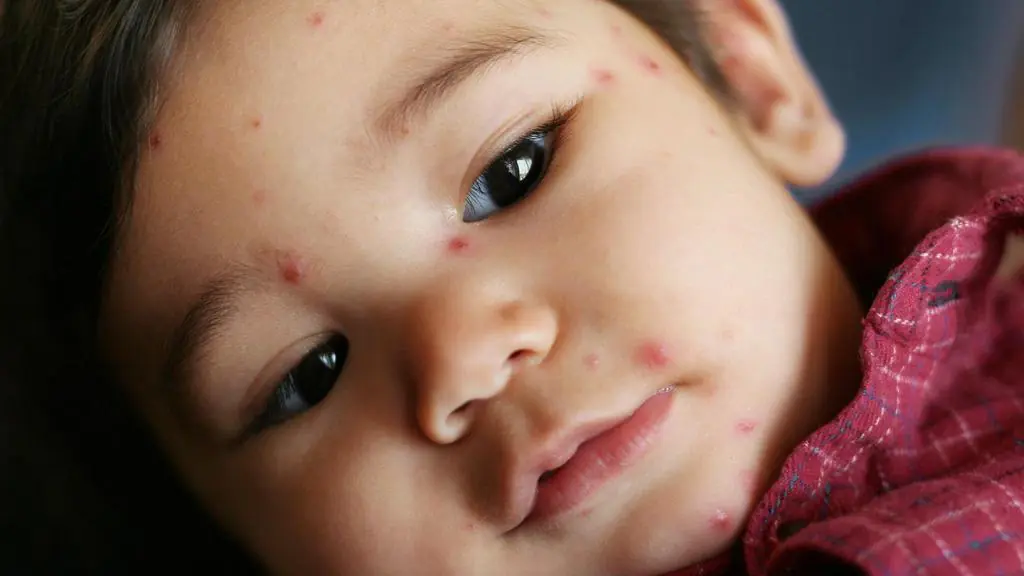
Non-infectious acne in children of different ages
Regardless of age, doctors distinguish between infectious and non-infectious types of acne. The first category includes the following rashes:
- Prickly heat.
- Hormonal acne.
- White dots.
- Allergic reaction.
- Pustules.
In most cases, acne on a child’s face does not indicate serious health problems. The most harmless rashes on this list include white pimples and hormonal acne. Other types of non-infectious rashes should be checked by a doctor to determine further treatment.
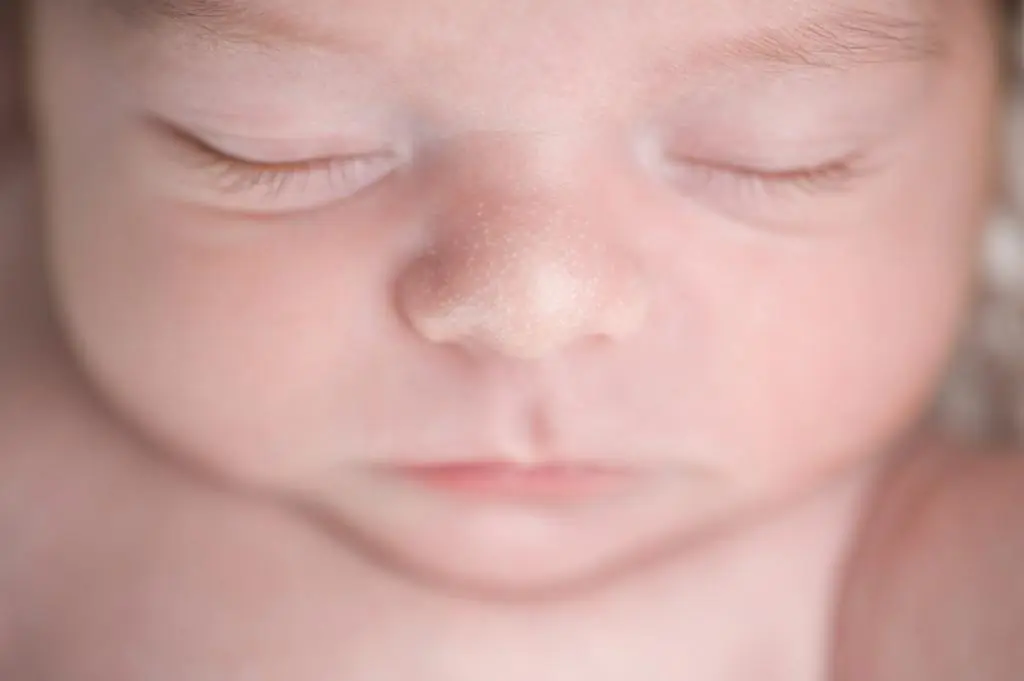
Infectious acne
These types of acne belong to the category of dangerous rashes. They are the main symptom of a viral infection in the body. Most often they appear when:
- Herpes. The rash is red and itchy. Very similar to small bubbles.
- Folliculitis. Pimples contain pus, hurt and can burst.
- Scarlet fever. The disease manifests itself as itchy and dry small pimples.
- Rubella. Pimples are pink in color and quickly spread throughout the body.
- Streptodermatitis. The rash has a distinct red outline.
Infectious acne on a child's face requires treatment, as does the disease itself that caused it. Therapy is carried out using medications, ointments, gels and creams to heal the skin.
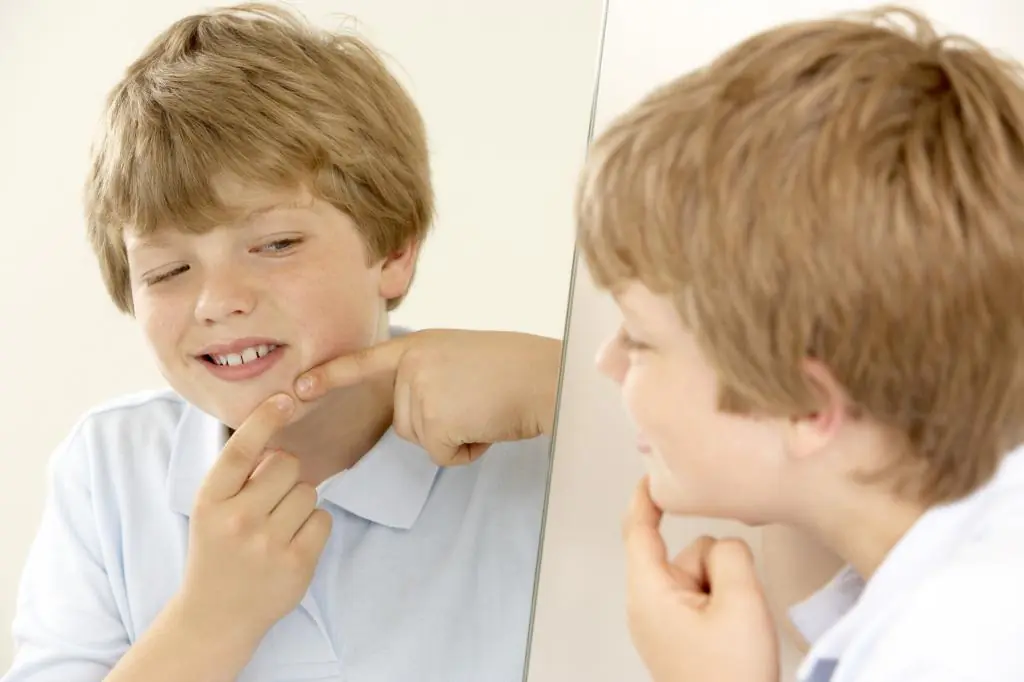
How to treat infectious acne on the face
When a child suffers from a viral disease, acne may appear on his face, which is considered one of the signs of a particular illness. Some diseases show their first symptoms in the form of rashes on the face. In this case, parents should go to the hospital in time and diagnose the infection in the baby’s body.
Next, doctors take care of his appropriate treatment. Therapy is most often carried out using antibiotics and other serious drugs. Acne on a child's face always goes away along with the infection during the recovery period. Therefore, it makes no sense to treat them separately, because they are only a consequence of the disease. However, during the treatment period it is necessary to ensure that the child adheres to the following recommendations:
- Pimples should not be squeezed, scratched or picked off. Otherwise, after recovery, scars will remain on your face and body.
- In order not to damage the wounds, you need to put special soft mittens on your child’s hands every night, which will prevent pimples from being ripped off the face.
- Treat rashes with a bactericidal solution every day.
If you follow these rules, your child’s recovery will be much easier.
Acne in babies
After birth, the child’s body has to adapt in every possible way to environmental conditions. He begins to live and develop separately from the mother's womb. Because of this new condition, his internal organs and skin begin to work even more actively. Therefore, many parents often encounter such a nuisance as acne in children.
In infancy, the child's rashes are white and red. The most harmless are small white pimples of a hormonal nature. They appear in the baby immediately after birth and can bother parents for a short period of time. The rashes are localized on the forehead, eyelids, under the eyes, and also on the cheeks. Pimples of this type closely resemble small white bumps. They don't hurt and rarely itch. Therefore, parents manage to quickly rid their baby of them.
Red pimples on a child's face are not always considered a harmless symptom. Such rashes can be caused by an inflammatory process in the body, which is caused by infection with microbes or viruses. They are also the result of improper hygienic care of the baby and failure to maintain a comfortable temperature in the room. Regardless of the cause of red pimples on the face of a child, you should immediately seek advice from a pediatrician.
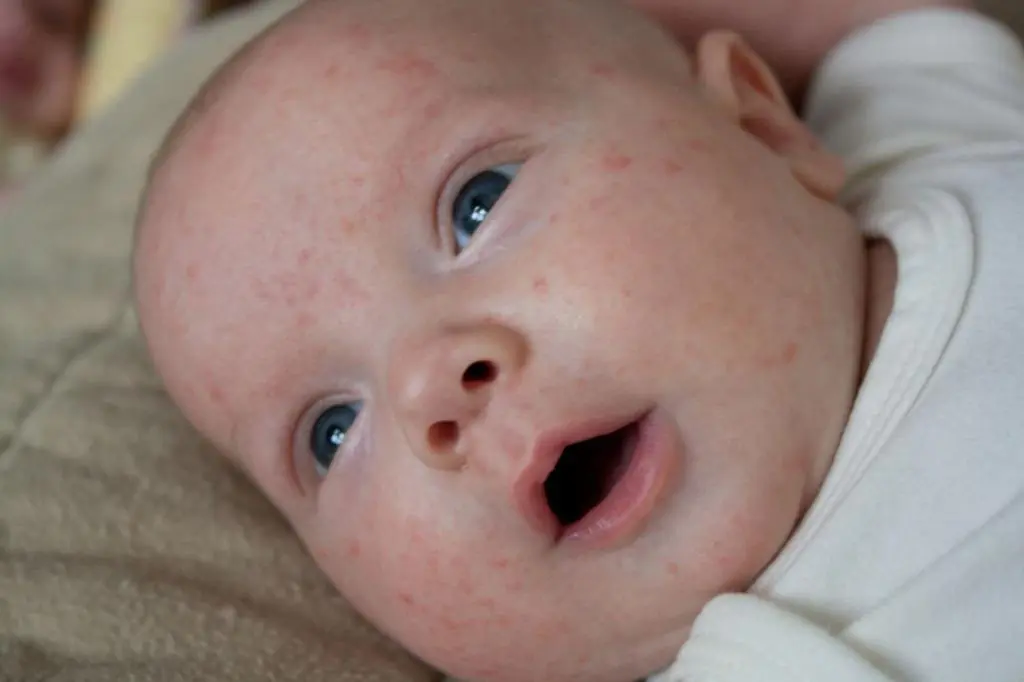
Types of acne in babies
During the first year of life, many children develop rashes on the skin of the face and body. They are mostly white or red. To determine the cause of their appearance, it is necessary to be able to distinguish between all types of acne, which most often appear in infants.
Milia are white and small pimples on the baby's face that do not cause him concern. If such acne appears on the face of a month-old baby, there is no need to worry. This type of rash is only a consequence of the normal functioning of hormones. They do not require treatment and go away on their own.
Infant acne is small purulent pimples that appear under the influence of the mother's female hormones. They should not be a cause for concern, but if the rashes persist, it is better to consult a doctor.
Miliaria is a very common occurrence in infants, which is manifested by redness of the skin in the neck and armpits. Such a deviation often occurs after non-compliance with the temperature regime indoors or outdoors.
Another type of most common rash in infants is allergic pimples. They can form from poor nutrition of the mother, inappropriate children's cosmetics, as well as from washing powder with an aggressive composition. If your baby is one month old, and acne on the face causes severe concern, it is better to consult a doctor.
Treatment of acne in babies
Depending on the type of acne, your doctor may prescribe the following treatment methods:
- Bepanten cream or powder from the same company. This is how diaper rash and prickly heat are treated.
- Baths with the addition of herbal infusions: sage, calendula, chamomile, string herbs, etc. With the help of medicinal herbs, you can remove white pimples on a child’s face, as well as remove all redness.
- For allergic rashes, a nursing mother is prescribed a strict diet. If your baby is fed artificial formula, it is necessary to reconsider his diet.
- Acne on a child’s body can be wiped with Furacilin.
- Some rashes will need to be treated with antihistamines.
- If you have chickenpox, you will be prescribed to treat the skin with regular brilliant green.
Every parent should remember that if a child has acne on his face, self-medication is dangerous. Especially when it comes to his health. Even the smallest red bumps on a baby's body should cause adults to see a doctor. Only he can prescribe the treatment the child needs.
Preventing rashes in babies
To prevent the development of rashes, it is necessary to promptly determine the causes of acne on a child’s face, provide good skin care, and also not neglect visiting doctors. Any self-medication can harm the baby’s health. Regardless of the type of rash, the body is first diagnosed. Only after a comprehensive examination can you carry out the treatment and prevention measures prescribed by your doctor. If acne appears on the face and body, consultation is given by an immunologist and an allergist.
Prevention of rashes depends on the age of the child. To prevent the appearance of acne in babies, it is necessary to control the temperature in the place where it is located, carry out bathing procedures only with organic cosmetics, and the mother will have to strictly monitor the feeding of the baby. When breastfeeding, you need to eat a strict diet, and when feeding artificial formulas, give preference to the most famous manufacturers.
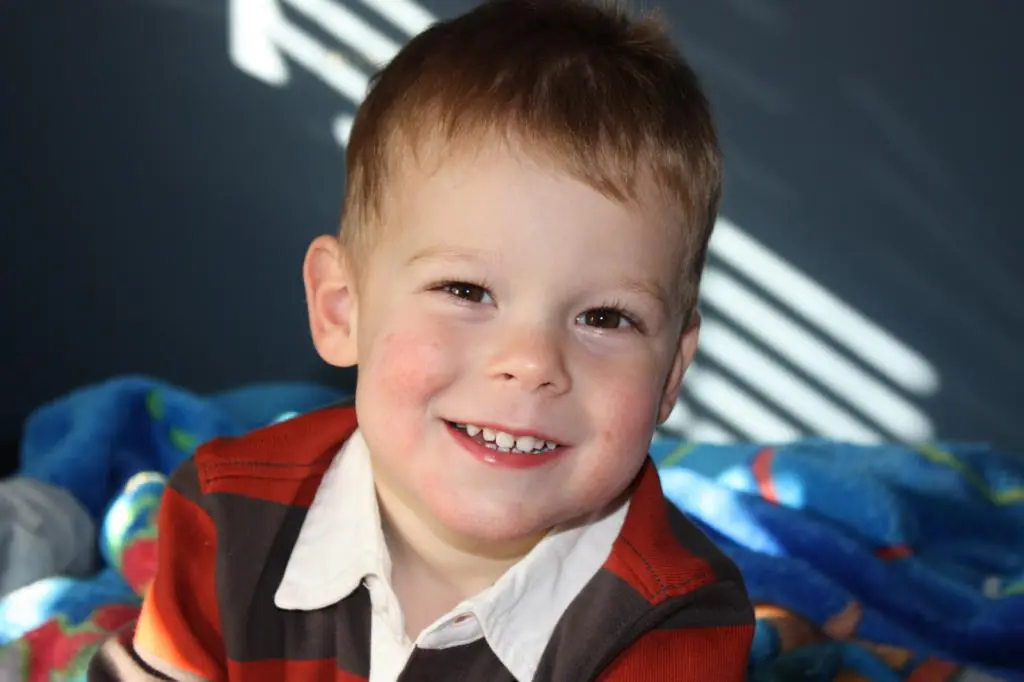
Acne in preschool and teenage children
Every mother will worry about the condition of her child when acne appears. And it doesn’t matter at all how old this child will be. Parents are always worried about the well-being of their child. Therefore, it is necessary to highlight the main causes of acne in preschool and adolescence:
- Teething. This process can cause a lot of discomfort to the baby and also cause rashes on the face. The location of such acne is always the area around the mouth. The reason for this is the child’s increased salivation during this period.
- Allergic reaction. Pimples of different diameters can occur in children due to allergies. These rashes are known for their rapid onset. An acne rash can spread across your face instantly. However, they are almost always accompanied by itching, runny nose, sneezing or tearing. Treatment is carried out by eliminating the allergen.
- The body's reaction after vaccination. It can be extremely individual. Therefore, they cannot be diagnosed at home. If pimples appear after vaccination, you should immediately consult a doctor.
- Lack of personal hygiene. Children's skin is very thin. Therefore, she reacts sensitively to the lack of quality cleansing. Teenagers may develop blackheads, and then acne. Therefore, you need to purchase soft and gentle cosmetics for washing.
- Insect bites. Red and swollen bumps on a child may indicate insect bites. Most often they are located unevenly and in different parts of the face and body. To prevent this from happening, it is necessary to use special creams that repel insects.
- Dysbacteriosis of the gastrointestinal tract. Judging by numerous photos, acne on a child’s face due to stomach problems looks like a small and itchy rash. It appears on the face, as well as around the hair growth on the head.
- Puberty. This type of acne can look quite scary. However, do not be scared and run to the doctor. Comedones, blackheads and acne appear in adolescence due to changes in the body. Over time, this age-related phenomenon passes. You just need to teach your child to eat right, drink more clean water and use special cosmetics that will help get rid of acne.
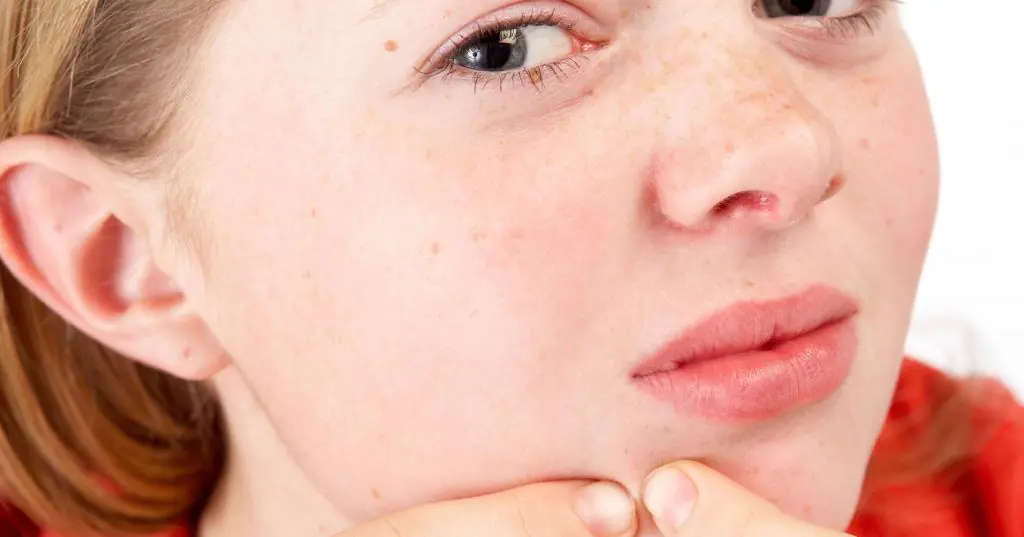
What should parents do if acne appears?
When a child has acne on his face, not all parents know what to do. Therefore, you need to try to prevent their occurrence. To prevent rashes in preschool children, you must first monitor their diet. In kindergarten or visiting friends, a child may eat a product that will cause him an allergy.
Particular attention should be paid to possible locations of acne. Having noticed a couple of pimples on the face, you need to immediately examine the child’s entire body. Some infectious diseases begin with rashes on the face and spread throughout the body. If you don't pay attention to small pimples, you may miss the symptoms of a dangerous infection.
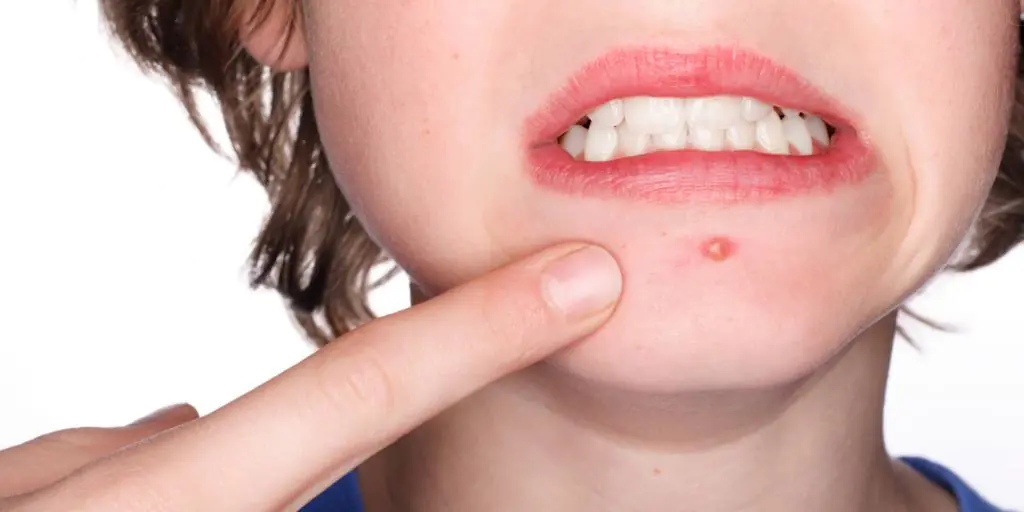
Preventing rashes in teenagers
As a teenager, you should always carefully monitor the condition of your facial skin. Acne during this period of a child’s life may appear due to hormonal changes in the body. The activity of the sebaceous glands begins to intensify, and this provokes the development of acne and blackheads.
Do not remove pus from pimples, squeeze them out or pick them off the skin. Such actions can only spread the activity of bacteria throughout the face. Even more pimples will appear after this. Parents should teach their child personal hygiene aimed at gently cleansing the skin and drying out inflamed acne. You can prevent their occurrence by normalizing your diet, increasing physical activity and walking in the fresh air.
The occurrence of acne on any part of the child’s body should not be ignored. Their manifestation may be associated with the presence of an infectious disease, due to a general weakening of the immune system.
Moreover, there are many reasons why they form. In medicine, it is customary to distinguish acne into groups: infectious, non-infectious and symptomatic.
The most common acne on the face of children are:
- colds: their appearance is due to a general decrease in the body’s immune system due to a cold;
- teenage acne.
The effectiveness of acne treatment depends on the time of starting the course of treatment for a cold. As a rule, doctors prescribe complex treatment, using various ointments and brilliant green for acne.
Prevention
To prevent colds, it is recommended to adhere to the following rules:
- avoid drafts, prevent hypothermia and increased sweating;
- When performing physical activity accompanied by sweating, immediately after finishing it, take a warm shower. Sweat contributes to skin irritation, resulting in acne formation;
- using warm baths with sea salt;
- maintaining immunity with the help of various vitamin complexes;
- healthy eating;
- recreational physical education;
- maintaining facial skin hygiene;
- correct and quick treatment of a cold at the first sign.
Treatment of teenage acne includes a whole range of measures. In the case of an infectious disease that leads to acne, consultation with a specialist is required.
One of the main allies in the fight against teenage acne is proper skin care.
To do this, use various creams, ointments, lotions for washing, they help cleanse the skin of dirt that has accumulated throughout the day, as well as frequent and abundant washing of the face with clean water.
Red large pimples on the butt and body of the child
There are many different reasons for the formation of large red pimples on the bottom and body of a child.
Depending on age, the following reasons are distinguished:
- Hormonal changes in the child's body. As a rule, the resulting acne goes away over time without the use of medications.
- Allergic manifestations. Often found in children when the mother’s diet is violated. Rashes can also be caused by hygiene products or the quality of clothing, food, dust, or the presence of pets. Such pimples are accompanied by itching and are very dangerous in terms of possible impact on the child’s health.
- Using low-quality diapers or using them for a long time.
- Hypothermia. Accompanied by abundant formation of red pimples on the child’s body, usually between the ages of two and seven years.
- Prickly heat. In children, very often, acne forms precisely for this reason.
- Infectious diseases. If there is a virus in the body (measles, chicken pox, herpes, rubella), painful, watery pimples may appear on the bottom and then spread throughout the child’s body. Large purulent pimples in a child also form under the influence of infection. Purulent formations (white or yellow) occur due to skin damage by staphylococcal bacteria. Pimples caused by infection should not be squeezed out, as this can lead to the formation of eczema. Most often, children become infected with these infections in kindergartens and schools.
- Nervous overstrain. In school-age children, stress conditions contribute to the formation of acne. They can be caused by adaptation to school, worries about the educational process and many other factors.
- Vaccination. Children's bodies can react specifically to vaccination, including the formation of acne on the butt and body.
- Various insect bites. The appearance of acne for this reason poses a great threat to the body. Bites can lead to allergic processes or viral damage to the body.
- Diabetes. Due to the increased sugar content in the urine, red acne may form on the baby's bottom.
How to treat purulent acne in men? More details here.
Video: Details
Appearance
In appearance, acne can be as follows:
- red rash;
- large acne;
- white pimples;
- pimples are yellow or white with red inflammation around the circumference (purulent).
Regardless of the cause of acne on the butt or body of a child, it is necessary to take measures to treat it in order to avoid complications.
In most cases, acne on the butt and body is observed in children under the age of one year, but there are exceptions. To prescribe the correct treatment, it is necessary to clarify the cause of acne.
Treatment
To treat most acne in children under one year of age, you should maintain proper hygiene, use baby powder, change diapers more often (reduce their use if possible), and take air baths.
In the presence of infectious diseases, a course of therapy is prescribed by a doctor. In case of observing an allergic reaction of the body, suprastin is most often used.
Very often, acne on the bottom and body of a child is treated with traditional methods. Such methods give effective results.
It can be:
- bathing the child with the addition of a decoction of herbs (chain, sage, birch buds, chamomile), you can also use decoctions to wipe acne;
- for acne caused by allergies, use a decoction of bay leaves: about ten leaves are placed in a pan, then a liter of water is added and put on low heat. Bring to a boil and cool, the resulting decoction is applied to the affected skin or added to bathing water;
- sea salt: dissolve five tablespoons of sea salt in one liter of warm water. Use to moisten acne or add to bathing water. This method is not recommended for children under two years of age.
Pimples on the nose, cheek and head of a child
Very often, large acne in a child appears on the face, including the nose, cheeks and head. In most cases, this is due to dysfunction of the sebaceous glands.
The following reasons for the formation of acne on the nose, cheeks and head of children, depending on age, are also identified:
- Teething: During teething, profuse salivation occurs. This promotes the formation of pimples around the mouth. Acne goes away over time when the amount of saliva produced returns to normal;
- prickly heat: the appearance of acne on the face is preceded by prickly heat in the neck, which gradually spreads to the face and head;
- puberty: when hormonal levels change, large acne appears on the face of adolescents;
- improper or insufficient care of the skin of the face and head: this can lead to the formation of purulent pimples or wen caused by clogging of the sebaceous glands;
- gastrointestinal disorders: due to various digestive disorders, acne may form on the face and head;
- nervous overstrain;
- infectious diseases.
Acne very rarely occurs in children aged four to seven years. But if large purulent pimples form on the nose, cheeks or head, it is necessary to undergo laboratory tests. This is due to the likelihood of various diseases in the child’s body.
The formation of acne in children from seven years of age to adolescence signals possible malfunctions in the functioning of various organs. In this case, it is necessary to study the child’s hormonal background.
Traditional therapy
Creams help slow down the functioning of the sebaceous glands. But many products contain antibiotics, so traditional methods of treatment are often used. Their main advantage is simplicity and accessibility, as well as efficiency.
Among them are:
- egg white mask: It is necessary to separate the yolks from the whites of a raw chicken egg. The whites are whipped until a thick consistency is obtained and applied to the skin of the face. Wash off the mask after twenty minutes. The remaining yolks are used to spread on the child’s acne before bedtime;
- baking soda solution: a handful of soda is moistened with water and applied to the face. After twenty minutes, you need to wash your face with warm water;
- boiled potato mask: Helps remove large white pimples. Crushed potatoes are mixed with a teaspoon of honey, two tablespoons of cream and a raw yolk from a chicken egg. Leave the mask on for fifteen minutes and rinse off;
- fruit masks: one of these contains orange and cherry pulp with the addition of flour. You will need two tablespoons of orange pulp and flour and four tablespoons of cherry pulp. Twenty minutes after application, you need to wash your face with warm water;
- tincture of calendula: pour calendula juice and flowers, in the amount of two tablespoons, with seventy milliliters of alcohol and fifty milliliters of water. Treat acne twice a day;
- yeast mask: Place ten grams of yeast in fifty grams of boiled water and add five drops of lemon juice. Apply the mask to your face for twenty minutes and then rinse off.
Should acne on a child’s body be left without proper attention, in the hope that it will go away on its own, or should we begin immediate treatment? This question certainly arises from time to time in every mother. The fact is that the immune system of a small organism is not yet sufficiently developed to resist various infections. Namely, acne is very often a characteristic symptom of infectious diseases.
What can cause acne to form on a child's body?
At any age (from infancy to adolescence), a child may suddenly develop pimples on the body. This usually happens for one of the following reasons:
- Teething. During the teething period, a baby experiences strong salivation. This is what can cause a rash to appear around the mouth. Such acne goes away on its own as soon as the amount of saliva produced normalizes.
- Prickly heat. Pimples on a baby’s body can often turn out to be ordinary prickly heat. More details about this can be found here.
- Allergy. Red pimples on a child’s body most often turn out to be a manifestation of an allergic reaction. Such rashes are usually accompanied by itching. Sometimes, along with the rash, the child experiences a runny nose and sneezing. And, if no other signs of a cold are observed, then most likely this is the action of an allergen. To eliminate these manifestations, it is imperative to identify and remove the cause that caused the allergic reaction.
- Reaction to vaccination. If a child was vaccinated, and soon after that the parents noticed a rash on the body, then it is possible that this is a manifestation of a reaction to the vaccine. In this case, you should immediately show the child to the doctor.
- Sunburn. A child's skin may be too sensitive to external influences. In addition to the sun, low temperatures or wind can negatively affect your baby's skin.
- Insect bites . Pimples caused by insect bites can be very dangerous. They often cause allergic reactions and even infection with certain infectious diseases.
- Puberty. Various acne very often appear on the face of teenagers. The reason for their appearance is a hormonal imbalance. As a rule, they go away over time, but teaching your child how to properly care for their skin during this period will not be superfluous.
- Insufficient skin care. Delicate baby skin needs constant careful care. Failure to comply with hygiene rules can cause the appearance of purulent acne in a child or wen on the face.
- Acneiform rash. The occurrence of this problem is most often a consequence of the mother taking certain medications while carrying a child. An acneiform rash appears in the first six months of a child’s life. Currently, about 20% of newborns face this problem. . White pimples on a child’s nose most often occur as a result of hormonal changes in the body. They go away on their own when hormone levels stabilize.
- Streptoderma. It can manifest itself in children in various forms. It is a consequence of skin infection with streptococci.
- Staphylococcus infection. White purulent pimples in a child can occur due to infection with staphylococcus. This is a very dangerous disease that requires immediate medical attention.
- Chickenpox, measles, rubella. These are childhood infectious diseases. When infected, a child develops pimples on different parts of the body. As a rule, such infections are accompanied by fever, sore throat, general weakness, headache, etc.
- Diabetes. With this disease, children may experience acne on the butt or genitals. The cause of the rash is the high sugar content in the urine.
- Intestinal dysbiosis. Small pimples on a child's face are a characteristic sign of this disease. They can also appear in the eyebrow area, on the head, and sometimes on the entire body.
Acne on a child's body in the first months of life
The appearance of pimples can tell you about the reasons for the appearance of a rash on a child’s body.



